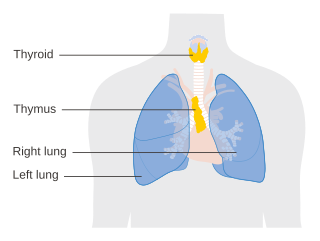Related Research Articles

The immune system is a network of biological systems that protects an organism from diseases. It detects and responds to a wide variety of pathogens, from viruses to parasitic worms, as well as cancer cells and objects such as wood splinters, distinguishing them from the organism's own healthy tissue. Many species have two major subsystems of the immune system. The innate immune system provides a preconfigured response to broad groups of situations and stimuli. The adaptive immune system provides a tailored response to each stimulus by learning to recognize molecules it has previously encountered. Both use molecules and cells to perform their functions.

The thymus is a specialized primary lymphoid organ of the immune system. Within the thymus, thymus cell lymphocytes or T cells mature. T cells are critical to the adaptive immune system, where the body adapts to specific foreign invaders. The thymus is located in the upper front part of the chest, in the anterior superior mediastinum, behind the sternum, and in front of the heart. It is made up of two lobes, each consisting of a central medulla and an outer cortex, surrounded by a capsule.

Agnatha is a paraphyletic infraphylum of non-gnathostome vertebrates, or jawless fish, in the phylum Chordata, subphylum Vertebrata, consisting of both living (cyclostomes) and extinct. Among recent animals, cyclostomes are sister to all vertebrates with jaws, known as gnathostomes.

Gnathostomata are the jawed vertebrates. Gnathostome diversity comprises roughly 60,000 species, which accounts for 99% of all living vertebrates, including humans. Most gnathostomes have retained ancestral traits like true teeth, a stomach, and paired appendages. Other traits are elastin, a horizontal semicircular canal of the inner ear, myelin sheaths of neurons, and an adaptive immune system which has discrete lymphoid organs, and uses V(D)J recombination to create antigen recognition sites, rather than using genetic recombination in the variable lymphocyte receptor gene.

A cytotoxic T cell (also known as TC, cytotoxic T lymphocyte, CTL, T-killer cell, cytolytic T cell, CD8+ T-cell or killer T cell) is a T lymphocyte (a type of white blood cell) that kills cancer cells, cells that are infected by intracellular pathogens (such as viruses or bacteria), or cells that are damaged in other ways.

The major histocompatibility complex (MHC) is a large locus on vertebrate DNA containing a set of closely linked polymorphic genes that code for cell surface proteins essential for the adaptive immune system. These cell surface proteins are called MHC molecules.

A lymphocyte is a type of white blood cell (leukocyte) in the immune system of most vertebrates. Lymphocytes include T cells, B cells, and innate lymphoid cells, of which natural killer cells are an important subtype. They are the main type of cell found in lymph, which prompted the name "lymphocyte". Lymphocytes make up between 18% and 42% of circulating white blood cells.

The adaptive immune system, also known as the acquired immune system, or specific immune system is a subsystem of the immune system that is composed of specialized, systemic cells and processes that eliminate pathogens or prevent their growth. The acquired immune system is one of the two main immunity strategies found in vertebrates.
In immunology, central tolerance is the process of eliminating any developing T or B lymphocytes that are autoreactive, i.e. reactive to the body itself. Through elimination of autoreactive lymphocytes, tolerance ensures that the immune system does not attack self peptides. Lymphocyte maturation occurs in primary lymphoid organs such as the bone marrow and the thymus. In mammals, B cells mature in the bone marrow and T cells mature in the thymus.
Immune tolerance, also known as immunological tolerance or immunotolerance, refers to the immune system's state of unresponsiveness to substances or tissues that would otherwise trigger an immune response. It arises from prior exposure to a specific antigen and contrasts the immune system's conventional role in eliminating foreign antigens. Depending on the site of induction, tolerance is categorized as either central tolerance, occurring in the thymus and bone marrow, or peripheral tolerance, taking place in other tissues and lymph nodes. Although the mechanisms establishing central and peripheral tolerance differ, their outcomes are analogous, ensuring immune system modulation.

Jan Klein was a Czech–American immunologist.
A thymocyte is an immune cell present in the thymus, before it undergoes transformation into a T cell. Thymocytes are produced as stem cells in the bone marrow and reach the thymus via the blood.

Immunoglobulin class switching, also known as isotype switching, isotypic commutation or class-switch recombination (CSR), is a biological mechanism that changes a B cell's production of immunoglobulin from one type to another, such as from the isotype IgM to the isotype IgG. During this process, the constant-region portion of the antibody heavy chain is changed, but the variable region of the heavy chain stays the same. Since the variable region does not change, class switching does not affect antigen specificity. Instead, the antibody retains affinity for the same antigens, but can interact with different effector molecules.

C->U-editing enzyme APOBEC-4, also known as Apolipoprotein B mRNA-editing enzyme catalytic polypeptide-like 4, is a protein that in humans is encoded by the APOBEC4 gene. It is primarily expressed in testis and found in mammals, chicken, but not fishes.

Allorecognition is the ability of an individual organism to distinguish its own tissues from those of another. It manifests itself in the recognition of antigens expressed on the surface of cells of non-self origin. Allorecognition has been described in nearly all multicellular phyla.

Max Dale Cooper, is an American immunologist and a professor at the Department of Pathology and Laboratory Medicine and the Emory Vaccine Center of Emory University School of Medicine. He is known for characterizing T cells and B cells.
Variable lymphocyte receptors (VLRs) belong to the Leucine-rich repeat (LRR) family and mediate adaptive immune responses in the jawless vertebrates, lampreys and hagfish.
Immunological memory is the ability of the immune system to quickly and specifically recognize an antigen that the body has previously encountered and initiate a corresponding immune response. Generally, they are secondary, tertiary and other subsequent immune responses to the same antigen. The adaptive immune system and antigen-specific receptor generation are responsible for adaptive immune memory.

Nina Papavasiliou is an immunologist and Helmholtz Professor in the Division of Immune Diversity at the German Cancer Research Center in Heidelberg, Germany. She is also an adjunct professor at the Rockefeller University, where she was previously associate professor and head of the Laboratory of Lymphocyte Biology. She is best known for her work in the fields of DNA and RNA editing.

Thomas Boehm is a German immunologist. He is a Director of the Max Planck Institute for Immunobiology and Epigenetics in Freiburg im Breisgau. He has won a variety of prizes for his research work.
References
- 1 2 3 4 5 Guo, Peng; Hirano, Masayuki; Herrin, Brantley R.; Li, Jianxu; Yu, Cuiling; Sadlonova, Andrea; Cooper, Max D. (2009-05-27). "Dual nature of the adaptive immune system in lampreys". Nature. 459 (7248): 796–801. Bibcode:2009Natur.459..796G. doi:10.1038/nature08068. ISSN 0028-0836. PMC 2714547 . PMID 19474790.
- ↑ Kishishita, Natsuko; Nagawa, Fumikiyo (March 2014). "Evolution of adaptive immunity: implications of a third lymphocyte lineage in lampreys". BioEssays. 36 (3): 244–250. doi:10.1002/bies.201300145. ISSN 1521-1878. PMID 24853392.
- 1 2 3 Hirano, Masayuki; Guo, Peng; McCurley, Nathanael; Schorpp, Michael; Das, Sabyasachi; Boehm, Thomas; Cooper, Max D. (2013-08-11). "Evolutionary implications of a third lymphocyte lineage in lampreys". Nature. 501 (7467): 435–438. Bibcode:2013Natur.501..435H. doi:10.1038/nature12467. ISSN 0028-0836. PMC 3901013 . PMID 23934109.
- ↑ Cooper, Max D.; Alder, Matthew N. (2006-02-24). "The evolution of adaptive immune systems". Cell. 124 (4): 815–822. doi: 10.1016/j.cell.2006.02.001 . ISSN 0092-8674. PMID 16497590.
- ↑ Hirano, Masayuki (August 2015). "Evolution of vertebrate adaptive immunity: immune cells and tissues, and AID/APOBEC cytidine deaminases". BioEssays. 37 (8): 877–887. doi: 10.1002/bies.201400178 . ISSN 1521-1878. PMID 26212221. S2CID 20163604.
- ↑ Kasamatsu, Jun (January 2013). "Evolution of innate and adaptive immune systems in jawless vertebrates". Microbiology and Immunology. 57 (1): 1–12. doi: 10.1111/j.1348-0421.2012.00500.x . ISSN 0385-5600. PMID 22924515.
- ↑ Bajoghli, Baubak; Guo, Peng; Aghaallaei, Narges; Hirano, Masayuki; Strohmeier, Christine; McCurley, Nathanael; Bockman, Dale E.; Schorpp, Michael; Cooper, Max D. (2011-02-03). "A thymus candidate in lampreys". Nature. 470 (7332): 90–94. Bibcode:2011Natur.470...90B. doi:10.1038/nature09655. ISSN 0028-0836. PMID 21293377. S2CID 4417477.
- ↑ Mayer, Werner E.; Uinuk-ool, Tatiana; Tichy, Herbert; Gartland, Lanier A.; Klein, Jan; Cooper, Max D. (2002-10-29). "Isolation and characterization of lymphocyte-like cells from a lamprey". Proceedings of the National Academy of Sciences. 99 (22): 14350–14355. Bibcode:2002PNAS...9914350M. doi: 10.1073/pnas.212527499 . ISSN 0027-8424. PMC 137887 . PMID 12388781.
- ↑ Deng, Lu; Velikovsky, C. Alejandro; Xu, Gang; Iyer, Lakshminarayan M.; Tasumi, Satoshi; Kerzic, Melissa C.; Flajnik, Martin F.; Aravind, L.; Pancer, Zeev (2010-07-27). "A structural basis for antigen recognition by the T cell-like lymphocytes of sea lamprey". Proceedings of the National Academy of Sciences. 107 (30): 13408–13413. Bibcode:2010PNAS..10713408D. doi: 10.1073/pnas.1005475107 . ISSN 0027-8424. PMC 2922149 . PMID 20616002.
- ↑ Boehm, Thomas; Hirano, Masayuki; Holland, Stephen J.; Das, Sabyasachi; Schorpp, Michael; Cooper, Max D. (2018-04-26). "Evolution of Alternative Adaptive Immune Systems in Vertebrates". Annual Review of Immunology. 36 (1): 19–42. doi:10.1146/annurev-immunol-042617-053028. hdl: 21.11116/0000-0001-F62D-8 . ISSN 0732-0582. PMID 29144837.